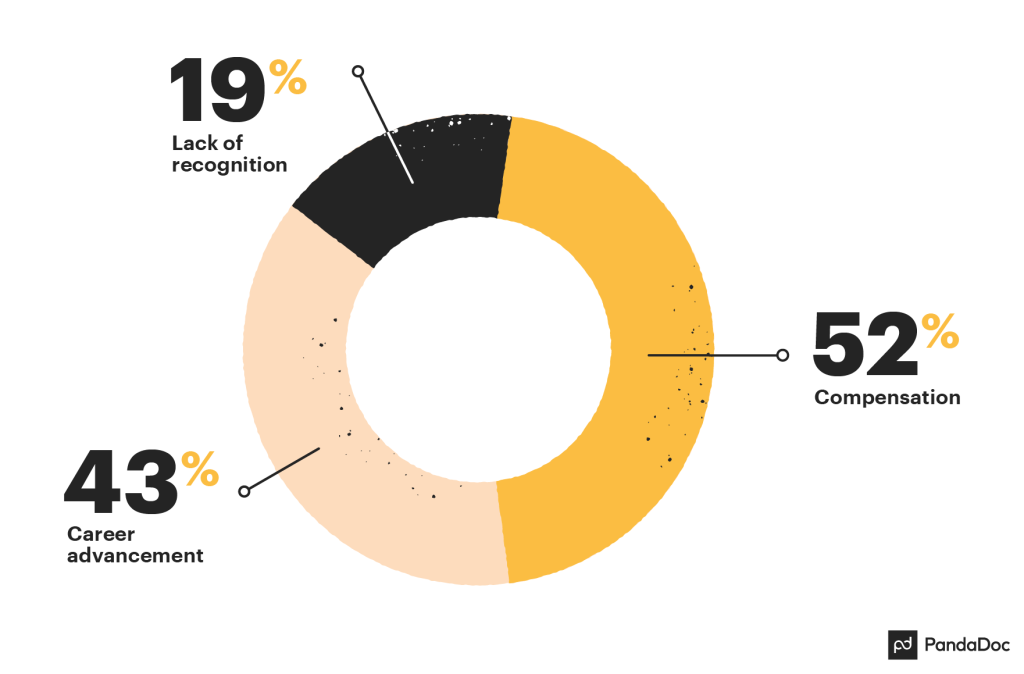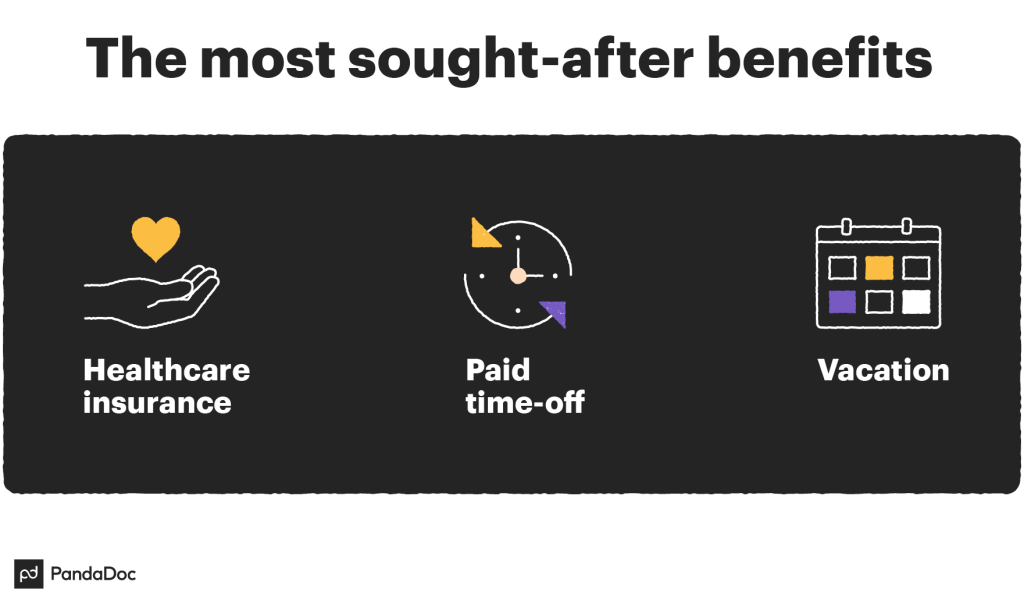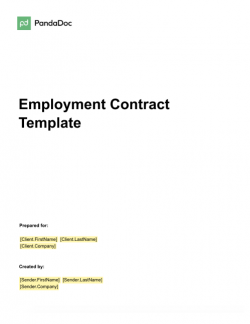If you’re a startup or small business, nailing down the finer points of an employment contract can be difficult.
Often, smaller companies manage to grow by either recruiting friends and family or by asking for recommendations from industry friends.
But all of that changes when you’re hiring an unknown candidate for a new job role. You’ll need to adopt some solid HR practices so that you can hire smart.
That means learning the basics of an employment contract and how to use software tools like PandaDoc to expedite your hiring process.
In this article, we’ll cover 7 basic items that every contract should include and how you can incorporate them into your hiring process.
Let’s get to it.
Legal disclaimer
Before we jump in, it’s important to note that employment law is complex and varied across different regions.
How you need to approach everything, from compensation packages to intellectual property or confidential information, will vary based on your location, your industry, and the legal requirements mandated by your local government.
While this content will give you a basic primer on employment contracts and what to include, it’s not intended as, or a replacement for, legal expertise.
01. Job information
When you start creating a new position, it’s important to define the role and what roles and responsibilities are associated with it.
Some key pieces of information to include might be:
- Job title
- Job description
- Team & department assignment
- Role requirements
- Skill requirements
- Education requirements (if any)
Much of this information will actually make it to the advert or job posting that you use to source potential hires.
If you’re creating a brand new position, you’ll need to clearly define the scope of the new role.
Consider how performance will be evaluated, to whom the new hire will report, what tools they should use, and what they are ultimately expected to accomplish.
In many cases, you may be able to work backward from an intended outcome to create a position that produces a given result.
You might also perform job searches on popular hiring websites and analyze roles that are similar to those that you intend to hire for.
It can take a considerable amount of time to get the details right, but it’s worth the effort since many of these positions are likely to become essential or permanent roles within your company.
Rather than rushing to send job offers to candidates who won’t have a clear understanding of the work, take the time necessary to define the role appropriately for your organization.
This will help to counter any confusion or misunderstanding before it happens so you can avoid high turnover.
Taking these steps early will also help recruiters and hiring managers source candidates and narrow your selection pool according to the scope of the role.
These factors make taking time to get the basics right more important than ever.
Once you have all of that information, it’s time to plan for the future. Go ahead and start an employment contract template that you or your HR team can use for all relevant hires.
Add all relevant job information in its own section of the template (so that it’s easy to swap out), and add any standardized company policies on subsequent pages.
Duplicate this template for every position you need to create and tailor each contract to fit the scope of the role you need to hire for.
02. Compensation and benefits
One of the most important factors when creating an employment contract will be the compensation and benefits package.
This package should include the following information:
- Annual salary or hourly rate
- Raises, bonuses, incentive opportunities
- Health benefits (medical, dental, eye care, etc.)
- Company stock options
- 401k or other investment/retirement plans
- Signing bonuses
- Other fringe benefits
Prospective candidates will want to know about compensation early in the interview process, and the rate of pay and benefits will greatly affect the quality of the candidates that you receive.
While you can probably get by with the high-level details during the recruitment process, you’ll need to have specifics in place when it’s time to draw up the contract and finally bring your new hire on board.
It’s also worth noting that compensation packages are a key factor when it comes to employee turnover.
According to one study, over half of respondents said that compensation is the top reason that they are looking for a new job or would consider leaving their current role.

Skimping on these benefits may save money in the short term, but it may also lower candidate quality or leave your company vulnerable to poaching from organizations willing to offer better rates.
Because of the long-term implications of compensation and how it will affect the longevity of any hire you make, it’s critical that everyone is clear on these details before any candidate sees an offer letter.
Depending on the role that you’re hiring for, you may not need to include every perk listed above.
A part-time employee at a retail store is unlikely to be looking for signing bonuses or stock opportunities as part of their compensation package.
That’s why it’s important to tailor every employment contract to fit the position.
PandaDoc makes that easy using tools like custom variables and the content library to help you tailor employment contracts to specific employees by making content blocks more modular.
If you’re flexible on pay rates (within a specific range), custom variables can help HR personnel know how much flexibility they have in negotiation.
03. Time off, sick days and vacation policy
While this might also be considered part of compensation and benefits, how employees accrue time off and ask for time away from work is important enough to cover within its own section of your contract.
With PandaDoc, you’ll add that section as part of a new content block with its own heading and separate text.
This approach is different from what you would see in Microsoft Word or Google Docs, and it allows you to quickly rearrange the content within your document by dragging and dropping content blocks on an as-needed basis.
But these policies aren’t something you should place within the fine print of your new contract. Even though they should stand alone as part of their own section, you’ll still want to leverage them as a perk.
According to research, vacation and paid time off are the two most sought-after benefits after healthcare and good insurance.

Your time off policy should thoroughly cover how time off is accrued when it can be taken, and what needs to happen for employees to tap those benefits.
In most organizations, some compensatory time off — like sick leave and vacation time — accrues and is awarded either in an annual lump sum or as part of a given pay period.
Be sure that your contract explains these accruals so that employees fully understand when those resources are available to them.
For paid vacation days, be sure to cover how and when this time is available to take, what the approval process looks like, and how employees can submit a request.
If vacation days increase with a long tenure, be sure to include that rate of increase and set maximum caps for that accrual.
Depending on the nature of your business, you may have certain blackout periods where scheduling vacation isn’t tenable for the company.
If that is the case, employees need to have a clear understanding of these restrictions and how they work.
You may even need to consider adding restrictive clauses to your employment contract if these dates are known factors that aren’t likely to change.
Sick days, family emergencies, and unpaid leave are often accompanied by a different set of expectations.
If you have restrictions or policy guidelines surrounding this information, be sure to point that out as part of your employment contract or hiring agreement.
Likewise, if employees have the opportunity to make up hours by working after-hours or during weekend events, it may be worth noting these opportunities and leveraging them to offset an unexpected employee absence.
04. Employee classification
While this might seem like a simple consideration, make sure that your new hire is appropriately classified as either an employee or a contractor in order to ensure tax and insurance compliance.
This is an issue of growing concern, especially in various regions across the US, where Uber and Lyft continue to fight lawsuits surrounding its alleged misclassification of employees.
How you classify employees in your job contract will affect what rights and benefits they have, as well as how much you can reasonably ask of them during negotiations.
For example, you wouldn’t have to provide health insurance to a contractor due to the nature of the relationship, but it may be harder to find contractors who are willing to sign an exclusivity clause or a non-compete that survives the period of time that they spend with you.
Before making this decision, be sure to learn what distinguishes employees from contractors and how you should handle hires that fall into both categories.
By taking the time to classify employees correctly from the beginning, you can save yourself from a headache and potential lawsuit farther down the road.
05. The schedule and employment period
Any hiring contract you create should clearly state if employment is full-time or part-time and whether employment is ongoing or scheduled for a set term after the initial start date.
Some job opportunities are only available on an as-needed basis.
While this may be great for contractors, job seekers looking for more stable employment or a more traditional role need to know early if their role has a predefined expiration date.
When defining this schedule, you’ll also need to include which hours an employee is expected to work as part of the employer-employee relationship.
If your business has set working hours where the employee needs to be available, use those hours to further define the role.
You’ll also need to include the number of hours that an employee is expected to work, along with any flexible working options (working from home, remote work while out of town, etc.) that might be available to them.
If the role has any exceptions to the employee’s standard working hours, take the time to define and explain those exceptions.
For example, if the role requires working nights or weekends, and that isn’t part of the regular work schedule, be sure to explain when and how often these irregularities are expected to occur.
If there are different rules for compensation surrounding the exceptions, such as a shift differential or holiday pay, take the time to cover that, as well.
One important thing to remember when deciding between full- and part-time employees is that some roles may actually hire for both. Especially in the service industry, it’s common for full-time roles to have a part-time variant.
In order to keep things neat and tidy, make sure that you keep your full-time contracts separate from your part-time contracts.
While there are a number of ways to do this, PandaDoc makes it easy by allowing you to rename your templates and sort them into folders.
Creating an organized and reliable system can eliminate confusion later on, so be sure to get off on the right foot when building your document library.
06. Confidentiality, privacy and responsibility
Whether it’s a secret process or a proprietary element, every business has trade secrets and client data that need to be protected.
Adding confidentiality agreements and non-compete agreements to your employment contract can go a long way in outlining these rules and regulations to employees as you’re bringing them into the fold.
Instead of making these documents into separate contracts or pieces of paper, include them as a section of the employment agreement and place a field in the section where new hires can digitally sign the document.
In PandaDoc, you can create user-assigned checkboxes to accomplish this task. Done this way, all of the clauses are built into your written agreement, but employees need to sign off (or initial) their acknowledgment of each clause as a condition of employment.
Depending on the nature of the work, you may also need to add additional clauses and restrictions to suit your needs regarding technology use on company property.
For example, if you don’t want employees to use company computers or mobile devices to update their personal social media channels or check personal email, this needs to be clear during the initial onboarding process.
The same goes for employees spreading negativity or bashing the company on social media platforms.
Many companies draw clear rules around what employees can and can’t say on social media regarding the company as a condition of employment.
However, keep in mind that even though it’s possible to add this as a contract provision, you need to set clear guidelines around these company policies to make them truly enforceable.
Be sure to check with qualified legal experts to ensure that any non-compete clauses and other employee restrictions will hold up to judicial review in your part of the world.
07. Termination, severance and survival
While it might feel early to be thinking about termination, it’s important to make plans to close the loop after either you or your employee decide that it’s time to part ways.
After all, nearly three million people in the US quit their job every month — and these numbers have held strong throughout the COVID-19 pandemic.
In the best scenarios, employees choose to leave voluntarily or the decision to end employment is a matter of mutual agreement. Unfortunately, this isn’t always the case.
As part of your employment contract, be sure to explain what is required for either party to terminate the relationship, including the amount of notice required and if it should be written.
What clauses and terms that you need to include will vary by the legalities in your region. At-will employment is common practice in the US, but this concept does not exist in most other parts of the world.
Be clear about what steps an employee needs to take in order to end the relationship and what notice your company will provide prior to releasing an employee from their contract.
Depending on the nature of the relationship and how the contract ends, you may also want to consider other factors in order to maintain a positive employer brand.
This might include offering severance packages or outplacement plans to help employees land on their feet.
Lastly, as part of your written contract, be sure to include any restrictions or mandates that a former employee must adhere to after leaving your organization.
These clauses should be written in such a way that they survive the contract for a set period of time after employment ends.
For example, an employee may not be allowed to start his or her own business in the same industry within the same locale in a specified time period or work with your company’s clients independently.
Take the time to clearly define these terms in order to help protect your business and clients.
Better employment contracts with PandaDoc
While these basic elements are a good starting point, there are plenty of other things you can include to further define the role or the business relationship.
To simplify writing the contract, use a digital template like the PandaDoc job proposal template to help guide your process.
With a seamless creation and a paperless signing process, your new hire will be on board in no time.
Originally published October 21, 2015, updated December 7, 2021
Disclaimer
Parties other than PandaDoc may provide products, services, recommendations, or views on PandaDoc’s site (“Third Party Materials”). PandaDoc is not responsible for examining or evaluating such Third Party Materials, and does not provide any warranties relating to the Third Party Materials. Links to such Third Party Materials are for your convenience and does not constitute an endorsement of such Third Party Materials.



